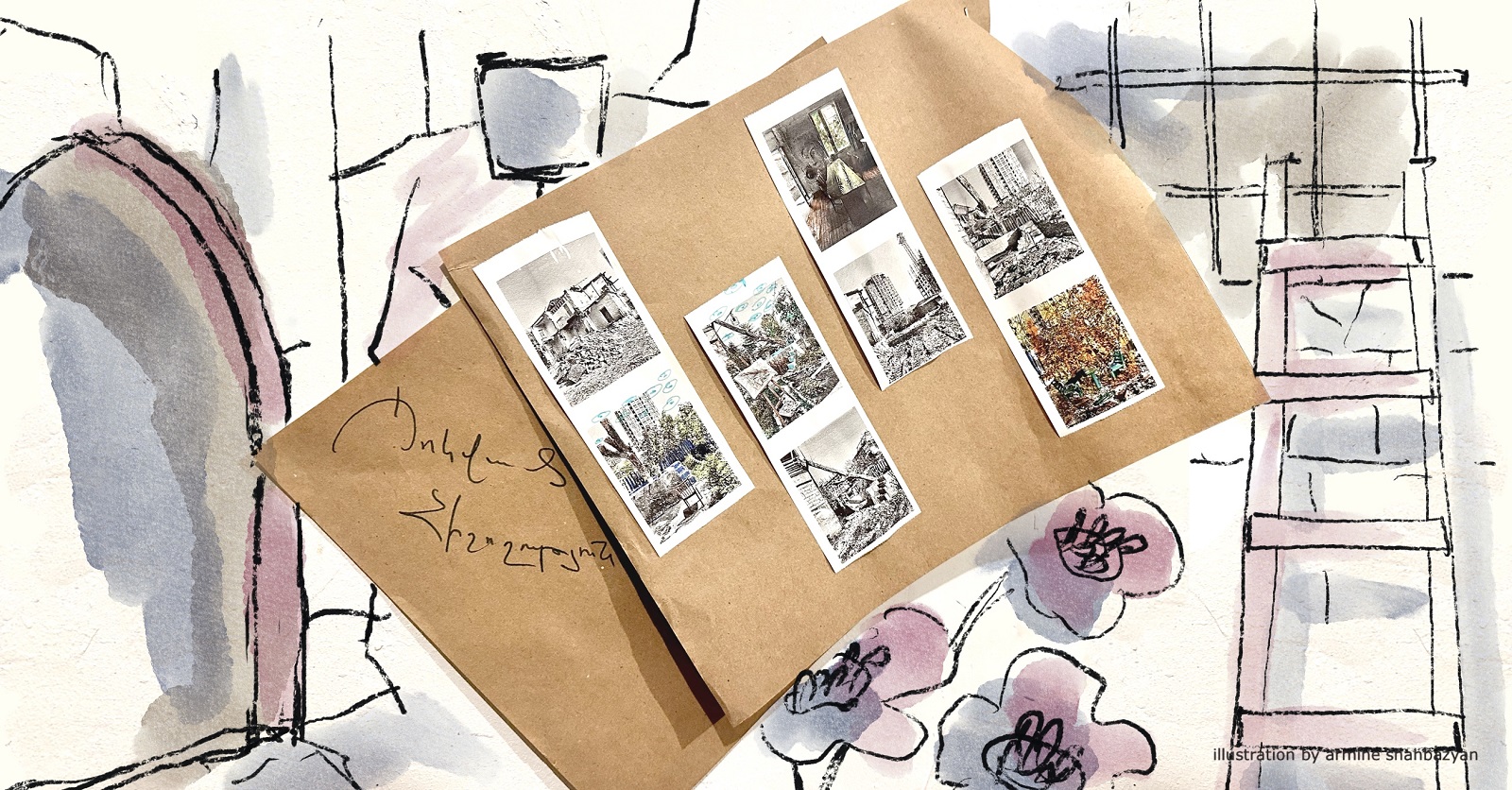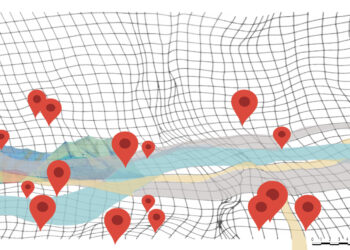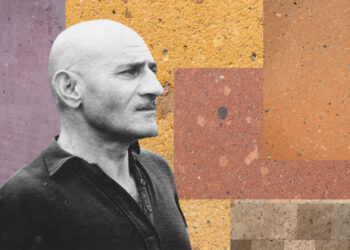
Listen to the article.
“They demolished the garden. They are kicking us out.” This was the short message we received from the Firdusi48_paintershouse Instagram page. News of developers destroying yet another part of Firdus was anything but unexpected given the vigorous demolition the neighborhood has seen over the past three years. However, it was pleasantly reassuring to see an art space stand its ground alongside the wave of activist resistance to the destruction of the community.
The neighborhood entrance was sealed off, but in House No. 48, eight artists opened their modest space on a closed street to share their connection to the neighborhood, reflect on their memories of the place, exhibit their artwork, and expose the destruction wrought by so-called “construction.” The two-day exhibition, featuring works by Angela Hovakimyan, Ani Shahverdyan, Lara Musaelyan, Anahit Movsisyan, Emilia Abgaryan, Siranush Aghajanyan, Marine Melkonyan, and Anahit Vardanyan, stood as an act of resistance—both as urban art activism and memory preservation. It offered a profound response to the question: What role does art play in times of crisis?
The destruction of Firdus has been unfolding since the early 2000s, when the Armenian government designated the entire neighborhood as eminent domain and began transferring it to developers. These developers, in turn, initiated compensation negotiations with the residents. However, the residents of Firdus were not willing to relinquish a neighborhood that their ancestors had built over centuries. Activist efforts to preserve the area, along with protests by residents and merchants from the local market, and numerous court cases challenging the neighborhood’s fate, have persisted for decades.
The first alley off Hanrapetutyun Street now lies entirely demolished and sealed off, along with the courtyards and homes once accessible through the archway from Tigran Mets Street. The houses behind the Armenian Center for Contemporary Experimental Art have also vanished, taking with them the musical instrument repair workshop. By early November, the gateway to Firdus—the portal on Tigran Mets through which one could escape from the city’s bustle into the realm of vernacular life—had also disappeared.
After the Book
The 2019 publication of the book “Firdus: The Memory of a Place” by CSN Lab served as a powerful act of resistance against the alienation and impending destruction of Yerevan’s vernacular neighborhoods and architectural heritage. It drew the attention of activists, human rights advocates, media outlets, and artists to the area. The preservation movement however lost momentum with the pandemic and the catastrophe of the 2020 Artsakh War. The old homes turned into construction pits, faceless, high-rise residential buildings grew out of them and spread like an incurable cancer. Yet, amid the dismantling of Firdus, with only a few families still remaining alongside the newly formed art community at House No. 48, a noticeable interest in memory and its forms of expression has taken shape, warranting public awareness and professional discourse.
Art-Firdus
The book on the memory of a place, coexistence, and vernacular architecture was a catalyst for the activist movement, one which reverberated through various artistic expressions and interventions—the “Old is beautiful” graffiti in the alleyway next to the red brick building on Hanrapetutyun Street (formerly Alaverdyan), art performances, exhibitions, walking tours of Firdus, small concerts—meanwhile, the constructors were deconstructing the historical neighborhood.
It is not only the story of Armenia’s art activism that has roots in Firdus, the neighborhood is home to numerous artists and architects who are inherently part of the cultural map of the neighborhood and Armenia. Naira Muradyan, author of the animated film “Firdus”; Robert Khachatryan, one of the photographers who documented Firdus; painter Haghtanak Shahumyan, who was born and raised in the neighbourhood; sculptor Benik Petrosyan, with his studio in the northern part of Firdus; the house of architect Hayk Kirakosyan… The story of art and Firdus is an endless tale, one that intensifies with every exploration of family history and every biography.
Place of Acceptance
For well over a century, Firdus has also been a place of acceptance and integration, a somewhat isolated neighbourhood concurrently functioning as an open space and a home for many “others”. Its history with immigrants is witnessed by its architectural topography and social memory. The architecture of Firdus was not simply vernacular; it arose based on internal agreements between its residents, accommodating co-existence and co-creation. Survivors of the Armenian Genocide, Azerbaijanis, Armenian refugees from Baku, Kurds, Iranians, repatriates who moved to Soviet Armenia from the Middle East during the Great Repatriation of 1946–1948, and traders who continue to live in Firdus all found a home there. In recent years, Firdus has also welcomed Iranians, Indians, numerous students, and, after the 2020 war, Armenians forcibly displaced from Nagorno-Karabakh. Endlessly layering the story of co-existence, Firdus continually served as a refuge for newcomers and those searching for their place in the city.
Only a couple of years ago, Firdus—House No. 48 to be precise—became home to yet another community: artists who have been painting, creating monotype prints, silk-screen prints, graffiti, and installations, as well as organizing various events and discussions. The community also welcomed forcibly displaced artists from Nagorno-Karabakh, for whom Firdus became both a shelter and a nurturing space.
Place of Collective Memory
Our research on memory of spaces and activism aims to peel back and expose delicate layers of memory. Examining networks of memory and how family stories intersect and intertwine, how they create an extensive web that ultimately shapes a neighbourhood’s collective social memory has been the primary objective of the research. Over the course of years of fieldwork, it has been an extraordinary experience to observe and unravel this network of intersecting narrative recollections with spaces. It is truly extraordinary to witness the amalgamation of a place with memories, to see how ordinary people, through their imagination, creativity and labor, have given form to a space, to trace the trajectory of the formation of collective memory passing through the intersection of personal memories. This makes the destruction of each house in Firdus not a flesh wound but a malign disturbance of the entire network and spatial entity of the memory of Firdus.
The artist’s home in Firdus, House No. 48, once a place for artistic dialogue, is now presented as a place of accumulation of memory. Over the course of two days, each artist paid tribute to their community and commemorated the bond with the collective while also offering a deeply personal story. The duality portrayed by the artwork mirrored a key conceptual conclusion of the “Firdus: The Memory of a Place” project—the duplexity of identities, external and internal. As if the art displayed at House No. 48 was inspired by the same source of multiplied identities—the intersection of internal and external memory.
Place of Resistance
Despite having to coexist with a persistent knowledge that the neighborhood will be gone someday, maybe tomorrow, the residents of Firdus remained persistently resilient. Today, the last of the families left are living amongst the ruins of their neighborhood. One of them, the new family that came together under the roof of House No. 48, has defined its language of resistance—unimpeded work and creativity.
The destruction of their garden and the looming threat of losing the house did not dishearten them; instead, it inspired a bold response. They announced an exhibition showcasing art created in and about that very space. “This is an artist’s statement in retaliation to the pressure that has been building since February 2024,” read their declaration.
Over two days, the eight women artists welcomed visitors, sharing the story of the place and the meaning behind their work. Firdus is a neighborhood deeply shaped by the memories of women, and now, the women of the art community are writing a new chapter—one of resistance, creativity, and defiance against the destruction of their beloved neighborhood.
A Collection of Memory
On that day, we barely managed to find the house. The pathways we once knew had vanished, metal sheets surrounding the construction pits had forged new and unknown paths.
We found House No. 48 with the help of an old friend, Davit from Firdus. The entrance to the house was shrouded in darkness. The construction workers, in their haste to move on to the roof after demolishing the yard, had damaged the electricity wires.
The doors opened and we were warmly greeted by Angela, Ani, Siranush, Lara, Emilia, Mane, and the two Anahits. Following a discussion about legal matters regarding the destruction of the garden, our hosts took us on a tour of the space. The first floor featured paintings, monotypes and installations. Marine Melkonyan’s “Uprooted Memories,” on the second floor, as the artist explained, was about witnessing and documenting imposed devastation and trauma upon the creative space and its residents and about the defender of that very space through their work.
The second floor hallway, lit by reddish lights, led us to Siranush’s installation “Manège” (playpen) on the wooden balcony. The playpen was filled with shattered glass and lights. Next to the “Manège,” on the timber logs of the balcony wall, a projection of one of the artist’s most vivid childhood memories—the disjointed light from the projection of the childhood photograph slipped through the openings between the logs, fused in the air and disappeared into the void.
Behind the gloomy void one could see the cranes, completing the new high-rise buildings imposed upon the city. In the “Manège,” filled with shattered glass, the space becomes even stronger, illustrating how the physical transforms into a stream of memory, ultimately turning into the memory itself. Firdus is a manège of memory.
Also see
Rethinking Monument Preservation in Armenia
Armenia is developing policies to inventory, preserve, restore and promote historical monuments, recognizing their economic and cultural value. While progress aligns with sustainable development goals, significant challenges in preservation and management persist.
Read moreThe Revered and Overlooked Legacy of Rafayel Israelyan
Rafayel Israelyan, one of the most prolific architects of the Armenian world, left an enduring mark on Armenia’s architectural landscape with his visionary designs that included memorials, fountains, bridges, churches, government buildings, and more. Despite his remarkable contributions, his legacy is underappreciated.
Read moreStereotypical Armenians and Armenian Stereotypes in Film
With a spotlight on Sean Baker’s film "Anora" that won the top prize at the Cannes Film Festival this year, Sona Karapoghosyan examines how evolving yet often reductive depictions in American cinema shape perceptions and cultural narratives about Armenians.
Read morePower Is (the) Truth
During March 2022, the Word—not only allegorically, but in the most literal sense—finds itself outstretched like the Vitruvian man strung from the corners of our Armenian-Russian-Ukrainian semiotic triangle.
Read moreHomekeeping
"Not a True Story But a Real Story" series is a reflection on individual transformations of collective identity and the concept of home. Armen of Armenia (Ohanyan) ponders why “housecat-like Armenians” didn’t just sit tight within their four walls when they could have become “heroes” by simply staying home.
Read moreKond: A City Within a City
A tucked away city within a city, the district of Kond in Yerevan has a rich history and a promising future only if authorities undertake a large-scale restoration. What are the stories of Kond and what does the future hold for one of the oldest quarters in the country’s capital?
Read more






